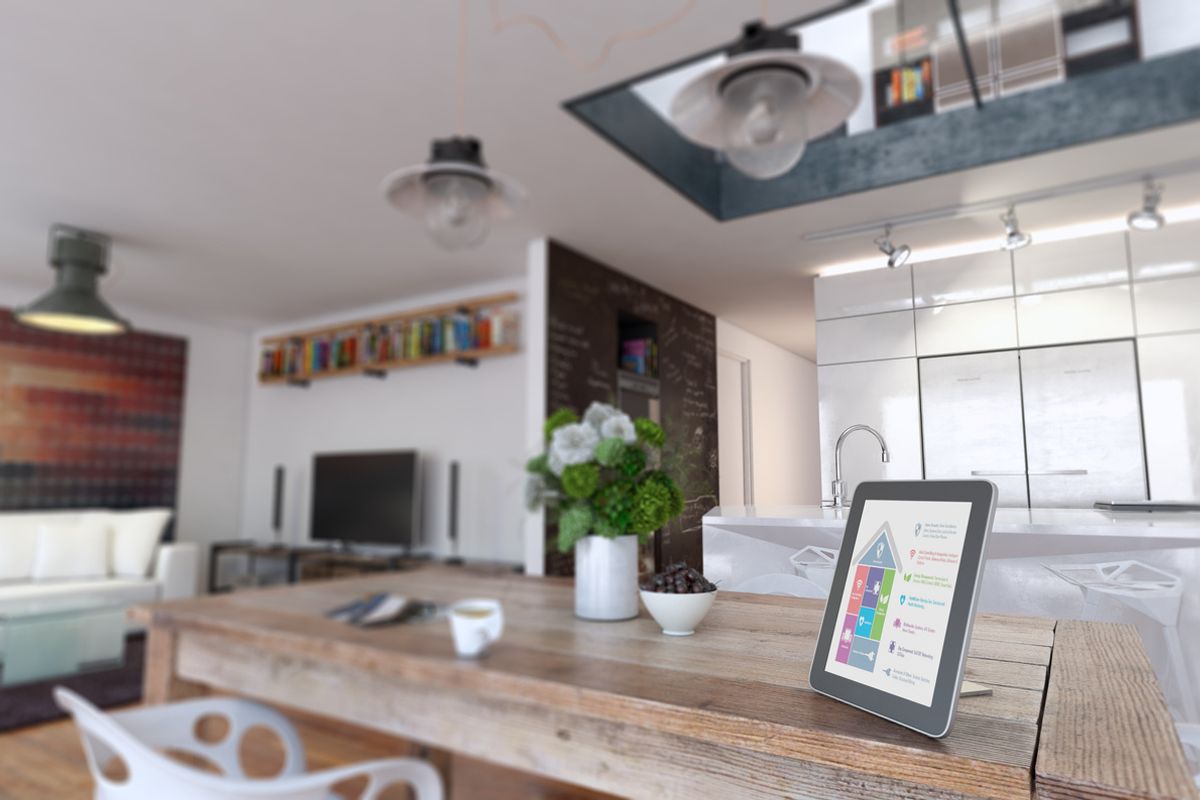
Resideo
The Ultimate Checklist for Setting Up a Clutter-Free Smart Home
Discover how to set up a smart home that’s neat, tidy, ultra-efficient and user-friendly.

Discover how to set up a smart home that’s neat, tidy, ultra-efficient and user-friendly.
Advancing technology and the Internet of Things (IoT) have turned the futuristic vision of a home powered by technology into a reality. Now, you can build your own smart home straight out of a science fiction movie.
Your smart home can make your living space safer, more personalized, and more enjoyable for your whole family. But ensuring it’s functional, responsive, and free from tech clutter takes effort.

A ‘smart home’ uses a network of interconnected technologies and devices to control various aspects of your living space. Smart tech can remotely control and adjust lighting, heating and cooling, security systems, and appliances.
Most devices connect to smartphone apps, and some are voice-activated for ease of use. This range of connected devices is known as a smart home ecosystem. A centralized, unified hub usually powers this ecosystem and uses Wi-Fi, Z-Wave, or Zigbee to send commands and other data to specific devices.
Consider which parts of your home you want to automate and which would bring you the most value. If you work remotely, this is an important factor, as is your budget.
When creating a clutter-free smart home, you should invest only in devices that will truly benefit you and your household. Remember, you can always start with a few carefully chosen devices and expand your smart device range as new needs arise.
Your smart home ecosystem refers to the network of devices you have connected and the platform they’re connected to. Once you’ve chosen your devices, you must pick a platform that aligns with your needs. Some of the most widely used and trusted options include Google Assistant, Amazon Alexa, and Apple HomeKit.
Most smart home systems rely on Wi-Fi connectivity to function. If you want your smart ecosystem to run smoothly, you need a fast and stable Wi-Fi connection to facilitate this.
For the best results, consider investing in a robust Wi-Fi router that supports using multiple smart devices. If you have a large home, you could opt for a mesh Wi-Fi system and extenders to ensure stable connectivity.
You may need to install a dedicated smart hub to power your smart home ecosystem. This is especially true if you have chosen smart devices connecting via Z-Wave or Zigbee.
Many platforms have app-based smart hubs, making it easy to establish a hub if you require one. These app-based hubs require little to no physical hardware and still support optimal operation of your home devices.
While smart technology is often integrated and wireless, you’ll still have cables for devices that can look messy and create clutter.
In this case, good cable management, trunking, and cable boxes are your friends. You can use them to manage, hide, or secure cables and keep them out of the way.

Once you’ve assessed your needs, chosen a smart home ecosystem, and ensured your Wi-Fi connection can support it, it’s time to select your smart home devices. Where possible, look for those that combine features, such as security and lighting, to avoid adding to the clutter.
Smart home security devices range from IoT-connected cameras, smart locks, and doorbells to CCTV systems. These devices typically connect to apps that allow you to control your home security settings remotely.
The systems will send notifications if unusual activity is detected, helping you to respond proactively to threats.
Smart thermostats can save you significant sums of money on your energy bills. They also make it easy to heat and cool your home remotely to keep the temperature ideal.
Some smart air conditioning and heating units have similar remote control features, adding to their functionality.
Smart light bulbs are a great investment for the eco-conscious home. They allow you to switch your lights on and off as needed using apps or voice activation. These bulbs can also be dimmed, helping reduce electricity usage and providing ambient lighting for your living spaces.
Voice assistants are a key feature of voice-controlled home devices. These devices allow you to easily control and manage the functions of your smart home using simple voice commands.
Options like Amazon Alexa and Google Assistant use artificial intelligence to recognize your commands and control your smart home devices accordingly. They can even be used to place online shopping orders.
Smart TVs and streaming devices provide seamless and intuitive access to various entertainment media. They use universal apps or remote controls to control your entertainment systems effortlessly.
Your smart home ecosystem lets you control smart appliances like ovens, refrigerators, robotic vacuum cleaners, and coffee makers from anywhere.
You can use the apps provided to make a pot of coffee without interrupting your work schedule, have your robot vacuum clean up before guests arrive, or adjust your fridge’s temperature while you’re out of town.
Devices like smart power strips and plugs can accurately monitor your home's energy usage and allow you to adjust and reduce your consumption remotely.
If you wish to create a truly energy-efficient smart home, consider installing smart meters or sustainable energy systems like solar.
Setting up a clutter-free smart home is simple once you know which systems best suit your needs. Investing in devices that bring you maximum value allows you to create an interconnected home ecosystem without numerous devices cluttering your living space.
Remember to keep your smart devices’ firmware versions updated for a safe and seamless experience and to gain access to their latest features. You can also use Gearbrain to find, buy, and connect any smart home device for a more streamlined experience.
Remember to use GearBrain, our smart home compatibility find engine. It can help you find, buy, and connect any smart device and find compatible products that work with your existing smart-connected devices, such as Google Assistant, Apple HomeKit, Samsung Smarthings, and Amazon Alexa-enabled devices.
GearBrain Compatibility Find Engine
A pioneering recommendation platform where you can research,
discover, buy, and learn how to connect and optimize smart devices.
Join our community! Ask and answer questions about smart devices and save yours in My Gear.
